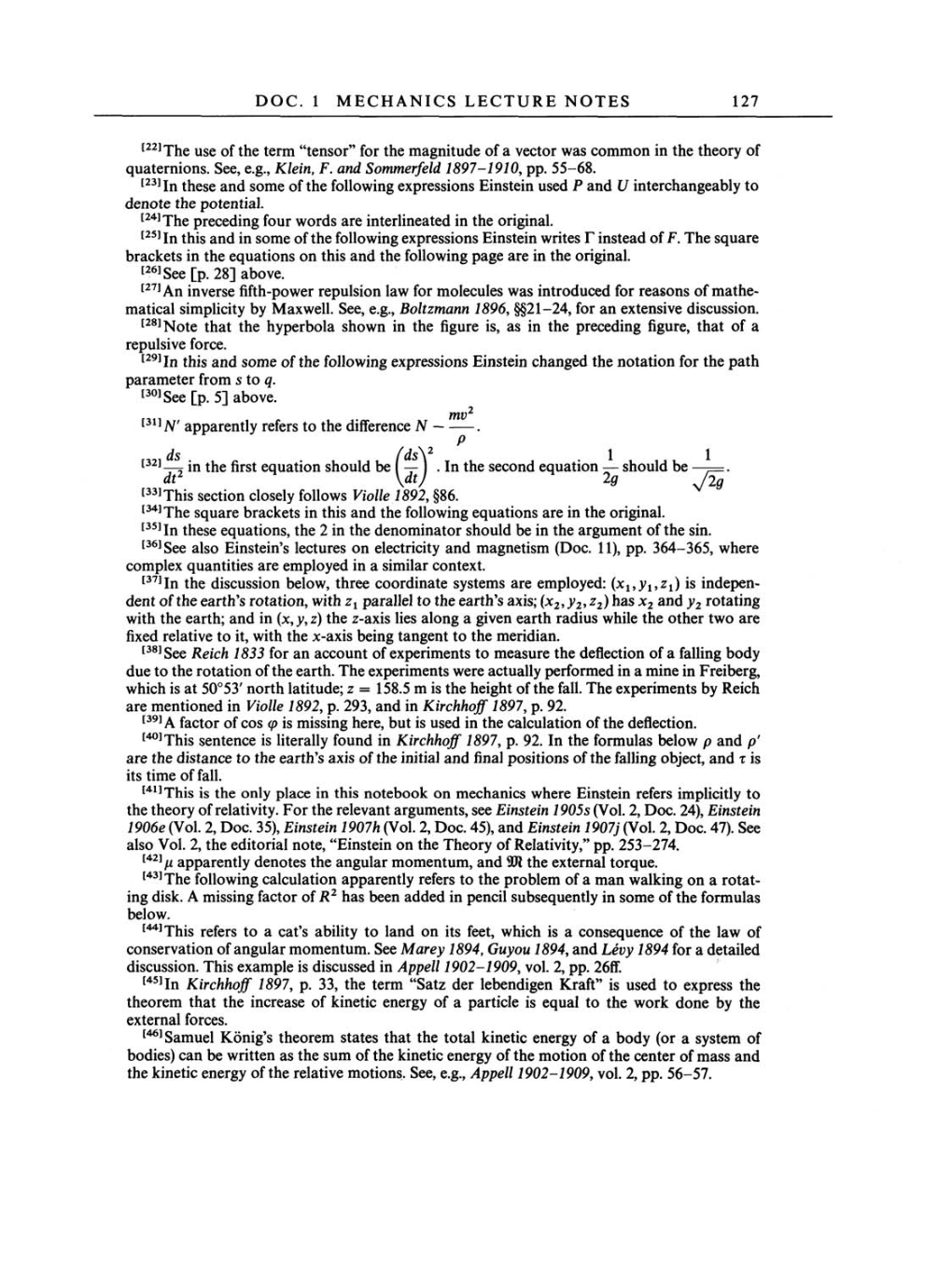DOC.
1
MECHANICS LECTURE NOTES
127
[22]The
use
of the
term
"tensor" for the
magnitude
of
a
vector
was common
in
the
theory
of
quaternions. See,
e.g.,
Klein,
F. and
Sommerfeld
1897-1910,
pp.
55-68.
[23]In these and
some
of the
following expressions
Einstein used P and
U
interchangeably
to
denote the
potential.
[24]The
preceding four words are interlineated
in
the original.
[25]In
this and
in
some
of
the following expressions
Einstein writes T instead of
F.
The
square
brackets
in
the
equations
on
this and the
following page are
in
the
original.
[26]See
[p.
28]
above.
[27]An
inverse
fifth-power repulsion
law
for molecules
was
introduced
for
reasons
of mathe-
matical
simplicity by
Maxwell.
See, e.g.,
Boltzmann
1896,
§§21-24,
for
an
extensive discussion.
[28]Note
that the
hyperbola
shown
in
the
figure is, as
in
the
preceding
figure,
that of
a
repulsive
force.
[29]In
this and
some
of the
following
expressions
Einstein
changed
the notation for
the
path
parameter
from
s
to
q.
[30]See
[p. 5]
above.
mv2
[31]N'
apparently
refers to
the
difference
N
-
P.
[32]ds-
in
the first
equation
should
be
(ds-)2
.
In the second
equation
-
should be
1-.
dt2
\dtj
2g
f2g
[33]This
section
closely follows Violle
1892,
§86.
[34]The
square
brackets
in
this and the
following equations are
in
the
original.
[35]In these
equations,
the
2
in
the denominator should be
in
the
argument
of
the sin.
[36]See also Einstein's lectures
on
electricity
and
magnetism
(Doc.
11),
pp. 364-365,
where
complex quantities are employed
in
a
similar
context.
[37]In the discussion
below,
three coordinate
systems
are
employed: (x1,y1,z1)
is
indepen-
dent of
the
earth's
rotation,
with
z1
parallel
to
the earth's
axis; (x2,y2,z2)
has
x2
and
y2
rotating
with the
earth;
and
in
(x,y,z)
the z-axis
lies
along
a given
earth radius
while
the other
two
are
fixed
relative
to
it,
with the x-axis
being tangent
to
the meridian.
[38]See Reich 1833
for
an
account
of
experiments to measure
the deflection of
a
falling body
due
to
the rotation of
the
earth. The
experiments were actually performed
in
a
mine
in Freiberg,
which
is at 50°53'
north
latitude;
z
=
158.5
m
is
the
height
of
the fall.
The
experiments
by
Reich
are
mentioned
in Violle
1892,
p.
293,
and
in
Kirchhoff 1897,
p.
92.
[39]A
factor of
cos
(p
is
missing
here,
but
is used in
the
calculation
of
the
deflection.
[40]This
sentence is
literally
found
in
Kirchhoff
1897, p.
92.
In the
formulas below
p
and
p'
are
the distance
to
the earth's axis of
the
initial and
final
positions
of
the
falling object,
and
t
is
its
time of
fall.
[41]This
is
the
only place
in
this notebook
on
mechanics where Einstein
refers
implicitly to
the
theory
of
relativity.
For the relevant
arguments,
see
Einstein
1905s
(Vol.
2,
Doc.
24),
Einstein
1906e
(Vol.
2,
Doc.
35),
Einstein
1907h
(Vol.
2,
Doc.
45),
and Einstein
1907j (Vol. 2,
Doc.
47).
See
also
Vol.
2,
the editorial
note,
"Einstein
on
the
Theory
of
Relativity,"
pp.
253-274.
[42]m
apparently
denotes the
angular
momentum,
and
9ft
the external
torque.
[43]The
following
calculation
apparently
refers to
the
problem
of
a
man walking
on a
rotat-
ing
disk.
A missing
factor of
R2
has been added
in
pencil subsequently
in
some
of the formulas
below.
[44]This
refers to
a
cat's
ability to
land
on
its
feet,
which
is
a
consequence
of the
law
of
conservation of
angular
momentum.
See Marey 1894,
Guyou 1894,
and
Levy
1894
for
a
detailed
discussion. This
example
is
discussed
in
Appell
1902-1909, vol.
2, pp.
26ff.
[45]In
Kirchhoff
1897,
p.
33,
the
term
"Satz der
lebendigen
Kraft"
is
used
to
express
the
theorem
that
the increase
of
kinetic
energy
of
a
particle
is
equal
to
the work done
by
the
external
forces.
[46]Samuel
König's
theorem states that the total kinetic
energy
of
a body (or a system
of
bodies)
can
be written
as
the
sum
of
the
kinetic
energy
of the motion of the
center
of
mass
and
the kinetic
energy
of the relative motions.
See, e.g., Appell
1902-1909, vol.
2,
pp.
56-57.
